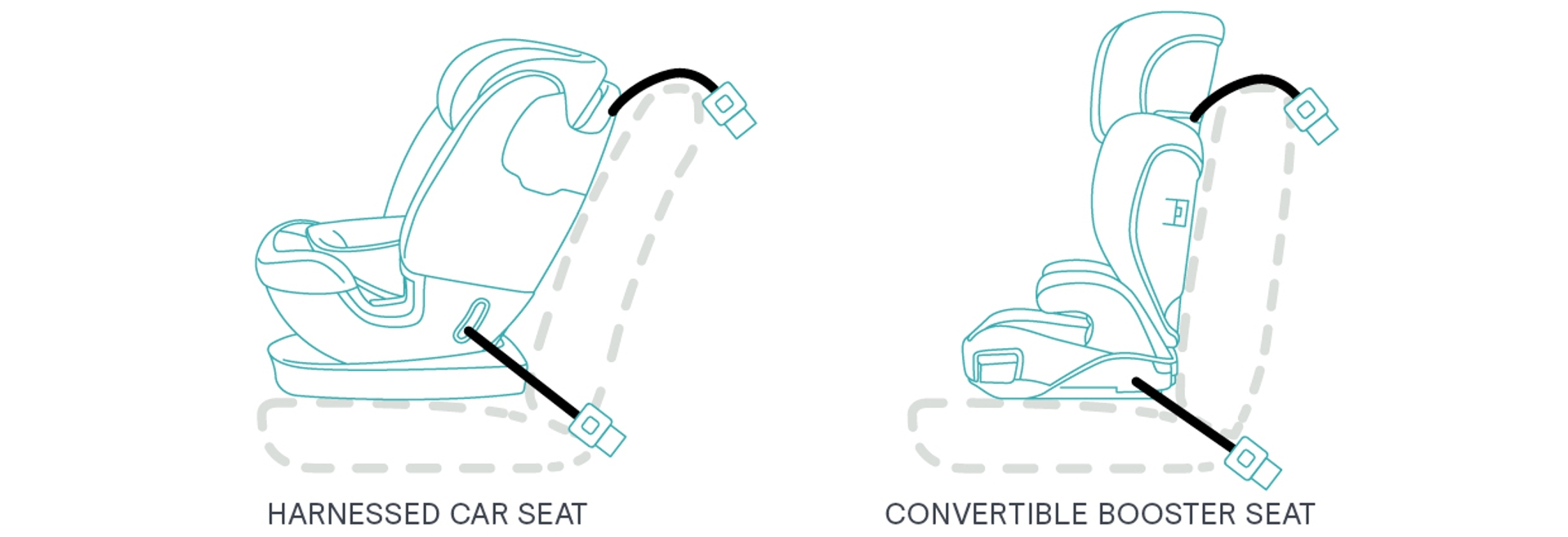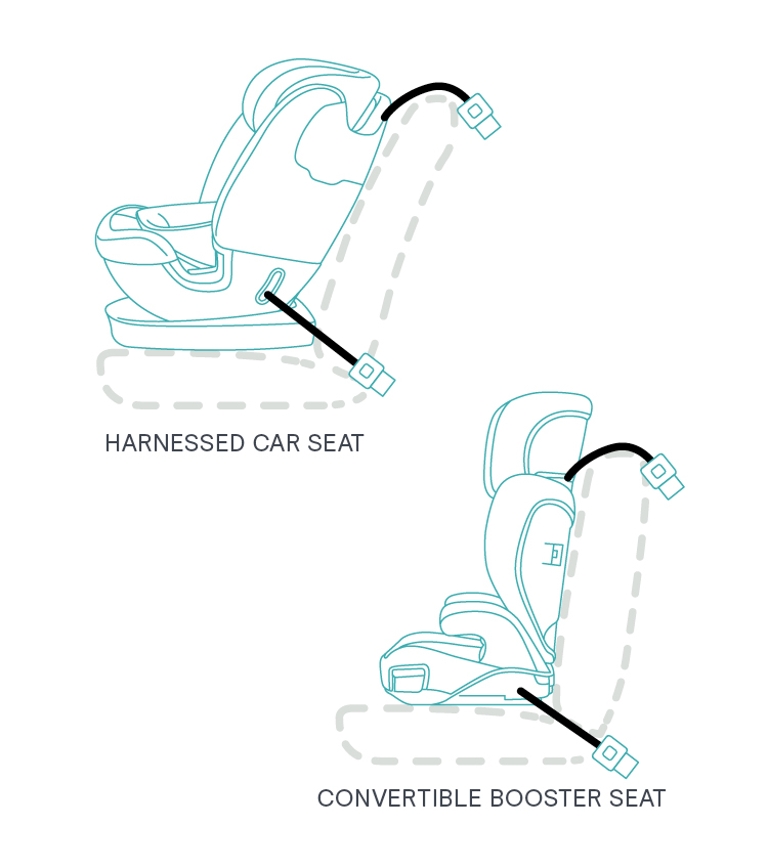Everything you need to know about harnessed car seats and convertible boosters

Car seat type: G (harnessed, forward-facing only),B/E (convertible booster). Age range: 12 months-8 years*
*This age range is a guide only. Your child may fit a seat for a longer or shorter amount of time depending on their seated height.
What's included in this guide:
- Benefits of a fully harnessed seat and benefits of a convertible booster
- Is a harnessed seat safer than a booster seat?
- Features to look for when purchasing a harnessed car seat
- When to raise the headrest in a harnessed seat
- When to convert from harnessed mode to booster mode in a convertible booster
- Information on second-hand 0-4 year convertible seats
What is a harnessed car seat?
A harnessed child car seat is a seat which has a harness with straps that go over the shoulders, around the hips, and a buckle built into the seat. It is only able to be used in a forward-facing mode, and so is not suitable for babies under 12 months old. In these car seats, the harness fits children until they are around 8 years old.
What is a convertible booster?
A convertible booster is like a harnessed car seat in that it also has an in-built harness and is forward-facing only, but these seats 'convert' to a seatbelt booster seat (meaning you remove the harness and only use the vehicle seat belt to secure your child) when your child is about 4 years old, provided they meet the height requirement to transition to a booster mode.
Which type of car seat should I buy for my toddler or child?
For children aged between 12 months and 4 years, you have a range of options including 0-4 convertible car seats, some of which have the added benefit of keeping your child safer by rear-facing them for a longer period.
Legally, even if you choose to face your child forwards at 12 months, until they are 4 years old your child will need to be in a fully harnessed car seat. So, when choosing your car seat, the decision is about how you want to restrain them from 4 years until they either outgrow the seat and you choose a new one or until they meet the 5-step test to stop using a car seat.
What are the benefits of using a harnessed car seat?
- Harnessed car seats have the benefit of offering improved protection for your child for longer – in an accident, a harness helps distribute the force more evenly across your little one’s body.
- The harness is more likely to sit correctly than a seatbelt – seatbelts have more movement, which can lead to them fitting poorly, which increases the risk of injury in a collision event.
- It is often easier to fit 3 seats across in your vehicle when you have harnessed seats as there is no need to reach down in between seats to buckle seat belts.
What are the benefits of using a convertible booster car seat?
- Convertible boosters can be a more affordable option over a fully harnessed seats, depending on brands, features and sales.
- If a fully harnessed car seat isn't an option, a convertible booster is a great option to meet legal requirements while helping your child be positioned better for a seat belt to restrain them.
Is a harnessed car seat safer than a booster?
The safest car seat for your child is one that meets legal requirements, is a suitable type for your child's age and development, is installed properly, and is adjusted correctly for your child's body. Harnessed seats may be safer than seatbelt boosters though, as a harness distributes force more evenly across your child’s body in an accident or sudden stop. It’s also more likely for a harness to be properly positioned on your child’s body, reducing risks associated with adult seat belts slipping out of position during a drive. Think about racing car drivers, who rely on harnesses every time they hit the track!
What features to look for when choosing a car seat for your toddler or child
Whether you’re planning to get a fully harnessed car seat, or are looking for a convertible booster seat instead, there are some features that can be handy to understand.
Safety and installation features
Easy-adjust harness
As your child grows, the height of the harness needs to change to ensure it will secure your child safely. To change the harness height in some seats, you need to uninstall your car seat, unthread the straps, rethread them to the new height, put the height of the headrest up separately, and then reinstall your car seat.
Other harnessed car seats offer an easy-adjust harness, where your headrest and harness can be lifted to the next level easily with the push of a button or lift of a lever. This feature is great for convenience, but also for safety, because:
- You aren’t uninstalling the car seat every time;
- The headrest height is automatically at the right level according to your child’s shoulder height.
By keeping the seat installed and automating the headrest height, this feature reduces the risk of human error, helping prevent simple installation and fitting errors that could otherwise be a potential risk factor for your child when you travel.
This feature isn’t available in all seats – you’ll find it on some harnessed seats and some convertible boosters.
Car seat dimensions
If you have a small vehicle, or you need to install more than one car seat in your vehicle, then the dimensions of the seat will be important to think about. While fully harnessed boosters can be wider than convertible boosters, if you do need to fit three child seats across your back seat, not needing to reach down between them to do buckles up is handy.
Also, consider your vehicle’s height and roof shape – some cars have ceiling angles that make it impossible to extend a headrest to its highest setting, so if you’re able to, test the seat in your car at its maximum height to see if you’ll get full use from it.
The other consideration is internal space inside the seat – not every child is built the same, and some have wider bodies, longer legs, or more petite frames, so may find different seats more comfortable than others. If you can, try seats out with your child to make sure they will be comfortable.
Tip: comfortable children are less likely to wriggle, helping keep them sitting properly in their seat and reducing distractions for you.
When should I raise the headrest and harness on a harnessed car seat?
When your child is forward-facing in a harnessed seat, the harness straps should come from the closest slot to their shoulders (this may be slightly above, or slightly below, the level of their shoulders). If you’re not sure when to raise the harness, you can check the manual for guidance specific to your model. Kids grow fast, so check the harness and headrest heights regularly to make sure your child is safe and comfortable.
When should I convert from harnessed mode to booster mode in a convertible booster?
Like other seats, convertible boosters come with height markers stitched into the covers which tell you when you can do certain things. For convertible boosters, the markers tell you when you can begin using the seat (entry marker), when you can switch the seat from harnessed mode to booster mode, and when the seat has been outgrown (exit marker). To use the markers, look at the level of your child’s shoulder where the harness strap or seat belt crosses it against the level of the marker. Being mindful to adhere to your state road law (currently not until the child is 4 years plus).
Should I purchase a second-hand harnessed or booster car seat?
While we understand it’s not an option for everyone, our experienced fitters recommend purchasing a new harnessed car seat or convertible booster if you’re able to do so.
We recommend this because second-hand child restraints may have invisible issues caused by impacts or accidents, incorrect washing of the cover, padding or shell, or poor storage between uses.
Sometimes a second-hand car seat is the best option for your family. If this is true for you, there are a few questions you can ask about the seat to reduce risk for your little one:
- What is the full history of the restraint? Has it been in an accident? Has it been stored and washed according to the manufacturer’s guidelines?
- Has the seat been visibly damaged or modified in anyway?
- Is the seat in line with current manufacturing standards, or does it meet previous versions of the standard?
- Is the restraint complete with all the components in place?
If in doubt, it might be worth looking for an alternative option that you feel confident about using.
To learn more about the different types of car seats, and the recommendations around using car seats for your child, head over to our car seat information page.
Alternatively, you can view our range of harnessed car seats and convertible boosters at our dedicated Harnessed Boosters page.




